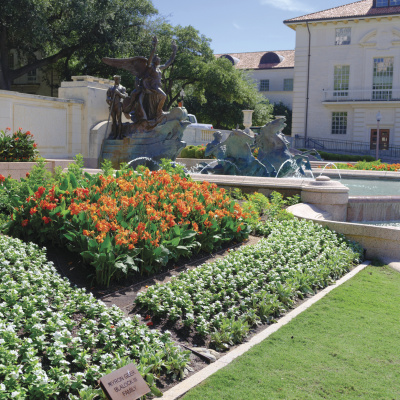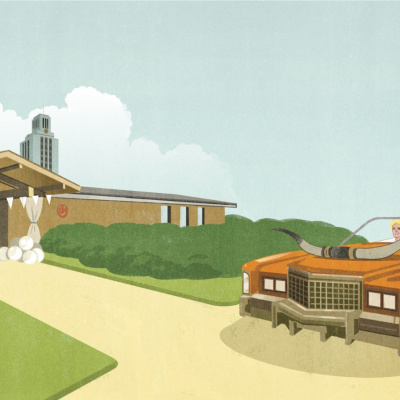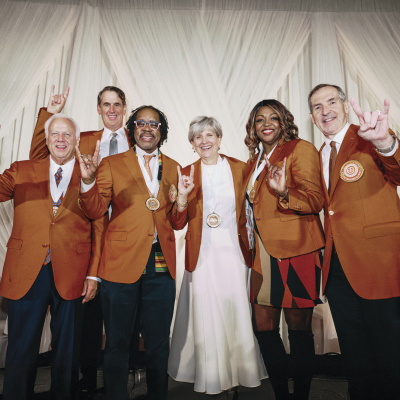The Tejas Club Celebrates Its Centennial

At the student thoroughfare of Rio Grande and 26th Street, flanked by climbing high-rises, a weathered, three-story, white Colonial Revival–style house remains.
On Thursday nights during the semester, nametagged students gather in the living room of the Tejas Club to listen to speakers ranging from oil executives to political organizers. After members introduce their friends joining them at the weekly “Tejas Coffee,” the spirit group’s vice president ends introductions by declaring, “I claim all unclaimed guests,” usually to answering snaps from the crowd.
Depending on the era, guest residents on the upper floors of the house could have included Harvard’s Fly Club—a similar organization at the Ivy League university—or the occasional avowed communist visiting from Chile’s Pedagogical Institute. As Tejas alumnus Charlie Bonner, BA ’18, Life Member, puts it, “The thing that binds us together is that we agree to bind ourselves together.”
State Representative Thomas Renfro and the other self-described “poor boys from B-hall” founded the Tejas Club while they were students in 1925. In the 100 years since, members have gone on to be federal politicians, Fortune 500 CEOs, and subversive artists. On April 5, Tejas will celebrate its centennial with a West Campus block party for hundreds of alumni.
Alejandro Flores, BBA ’14, took 10 years to return to 26th Street. He and his sister, Robie, arrived as Coffee speakers, following the release of their documentary about their hometown of Eagle Pass, Texas, and the loss of their brother, Marcelo, ’15, also a Tejas member. “[Serving as a Coffee speaker] was a dream I didn’t realize I had,” Flores says. “[Returning meant] carving space out for students on campus who are Latino, Mexican American, and Chicano.”
He didn’t arrive at Tejas with the same self-certainty. As a queer and Latino man, Flores “[wanted] to be perceived as worthy of being a part of something—and being masculine” when he first started “coming around” the house (the organization’s nebulous term for pursuing membership). He highlights the alumni who made it safe for members to be themselves, including James Arth, BBA ’81; Dr. John Feather, BA ’72; and Feather’s late husband, Steve Parsons. “They became the dads that I never had, that I could never have,” says Flores. “Why wouldn’t I want to have the love these guys enjoy every day?”
Feather, who was not openly gay while he was a student, admits that he was not always fond of some of his fellow members. “When I left, I thought, Well, if I never see you again, that’ll be too soon,” he says. After he graduated, Feather continued drifting away from the Club, assuming he would never be accepted for his sexuality. It wasn’t until 20 years later that he began reaching out to people again. “And of course, they [had grown] up, too. Everyone was more than accepting,” he says.

Feather re-involved himself in the Club, serving in nearly every possible role as a Tejas alumnus and cherishing opportunities for mentorship. “Students need somebody to talk to besides their parents,” he says. “There’s a magic to this.” His husband recognized it, too, and eventually the Club would induct Parsons as only its eighth honorary member in its history.
The Club’s enduring generosity toward its members allows for some of the “magic” Feather describes. Former Secretary of State Rex Tillerson, BS ’75, Life Member, Distinguished Alumnus, credits the Tejas Club’s monthly rent of about $25 for helping him afford to stay enrolled at UT. And Tejas gave more than it took: Scholarships to each member often outpace individual dues, and meals at the house cost just $5 into the late 2010s. But as the city’s median home price has tripled since 2010, Tejas’ insurance and taxes more than quadrupled.
Today’s membership financials have strayed further from the myth of Tejas, with only about 10 percent of members coming from households earning less than $100,000 a year, as of spring 2023. Gone are the days of Tillerson’s cheap rent, replaced instead with rent costs roughly on parity with other West Campus living situations and fees that have hiked from $500 up to $1,000 since 2020.
The Tejas Foundation was founded in 1953 to connect alumni to active members and provide affordable housing and scholarships. In 2017, Cal Chaney, BA ’75, JD ’78, Life Member, along with his family established the Texas Exes Tejas Club Campus Leadership Award, which is awarded annually to a Tejas member who displays outstanding leadership, integrity, unselfish devotion to The University of Texas, and mentorship, among other qualities. Tillerson also donated $1 million to the Tejas endowment on Texas Independence Day, March 2, 2024.
In spring 2019, the historically male spirit group Club changed its constitution to welcome all male-identifying and nonbinary prospective members, but no nonbinary members have since joined. “[Tejas] was more about how we celebrated our commonalities [rather than our differences],” says Tejas alumnus and former UT System Regent Alex Cranberg, BS ’77, Life Member. Three years ago, a woman joined the Club as a voting participant (though the honor was defined with a title distinct from membership).
Tejas’ approach to openness often arose from the commitments it fostered. Former student body president Joseph Krier, BA ’68, JD ’71, Life Member, came from a “strait-laced conservative family,” but he marched with fellow classmates against the Vietnam War because friends asked him to. “The Club changed my life because it taught me so much about getting along with people that I didn’t agree with,” Krier says.
On April 5, 2025, generations of Tejas members will return to the house, including Krier. He might pass a quote from former UT System Regent Frank Erwin, LLB ’48, Life Member, on the second floor, declaring, “We don’t fund anything we can’t control.” The two men struck up a friendship prior to Krier’s election as student body president. “Erwin told me, ‘Joe, if it will help you for me to support you, I’ll do that. If it will help you for me to publicly oppose you, I will do that, too,’” Krier says. “Student Government regularly was crossways with the Board of Regents.” But they needed each other, as much as it might have begrudged both bodies they served.
For nearly 100 years, Tejas has existed as both a reflection of and resistance to the preeminent currents of Texas life. But the house still stands. After the alumni gather there this spring for the centennial celebration, perhaps they will leave a little more convinced of its lasting lesson: that the friends they’ve committed to will always come around for them.
CREDITS: Jun Tan; Courtesy of the Tejas Foundation






